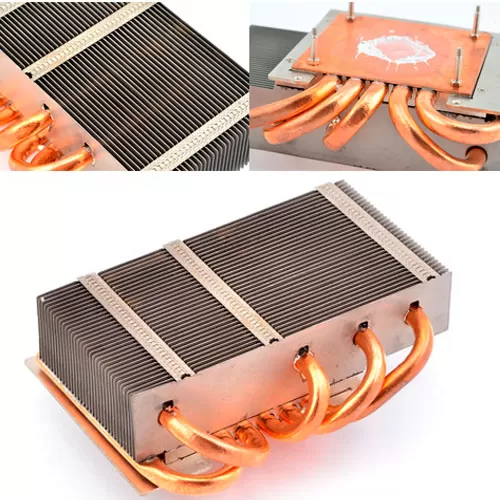The heat pipe heat sink consists of a sealed tube, a liquid wick and a steam channel. The liquid-absorbing wick surrounds the wall of the sealed tube and is immersed in a volatile saturated liquid. This liquid can be distilled water, ammonia, methanol or acetone, etc. Heat pipe heat sinks filled with ammonia, methanol, acetone and other liquids still have good heat dissipation capabilities at low temperatures.

When the heat pipe heat sink is running, its evaporation section absorbs the heat generated by the heat source (power semiconductor device, etc.), causing the liquid in the liquid-absorbing core tube to boil into steam. The steam carrying heat moves from the evaporation section of the heat pipe heat sink to its cooling section. When the steam transfers heat to the cooling section, the steam condenses into liquid. The condensed liquid returns to the evaporation section through the capillary action of the liquid wick on the tube wall, and the above cycle is repeated to continuously dissipate heat.
The heat pipe heat sink is a high-efficiency heat dissipation device with unique heat dissipation characteristics. That is, it has high thermal conductivity, and the temperature distribution along the axial direction between its evaporation section and cooling section is uniform and basically equal.
Advantages of Heat Pipe Heat Sink:
● The thermal response speed is fast, and its ability to transfer heat is more than 1,000 times greater than that of copper tubes of the same size and weight;
● Small size and light weight;
● High heat dissipation efficiency, which can simplify the heat dissipation design of electronic equipment, such as changing air cooling to self-cooling;
● No external power supply is required, and no special maintenance is required during operation;
● It has good isothermal properties. After thermal equilibrium, the temperature gradient between the evaporation section and the cooling section is quite small and can be approximately considered to be 0;
● The operation is safe and reliable and does not pollute the environment.


 +86-18902844286
+86-18902844286
 E-mail
E-mail
